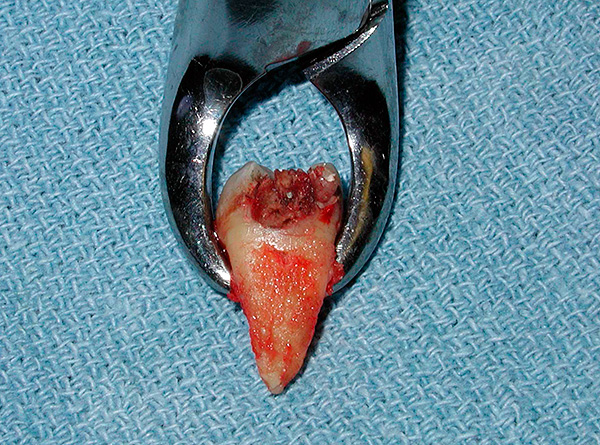
Next you will learn:
- How can the tooth extraction procedure be postponed with minimal losses for your health, nerves and wallet;
- Why teeth sometimes have to be removed and what indications a dentist-surgeon is guided by making an appropriate verdict;
- In what situations with tooth extraction is it better to wait a bit or not even remove it at all;
- What stages the procedure consists of and what awaits you in the dentist's office;
- Is it possible to remove teeth today without scary forceps, without pain and with minimal trauma;
- How difficult and lengthy can be the extraction of problematic teeth - refined, semi-resinized, resorcinol-formalin and even ordinary molars, but with specific roots;
- How can the patient help the attending physician so that tooth extraction can be carried out without problems;
- What to do if you need to urgently remove a tooth at night, on weekends or holidays;
- Is it possible to remove teeth in hospitals today for free and what is often hidden behind the cheapness of the service ...
Tooth extraction (extraction) is considered a dental operation and involves surgical intervention. In other words, going to remove a tooth, you are going for a surgical operation, and therefore you should take this procedure with all responsibility.
Further, we will consider many nuances that will help an ordinary unprepared person to go through this test with minimal losses for nerves, wallet and his health (patient errors and negligence can lead to very serious consequences).
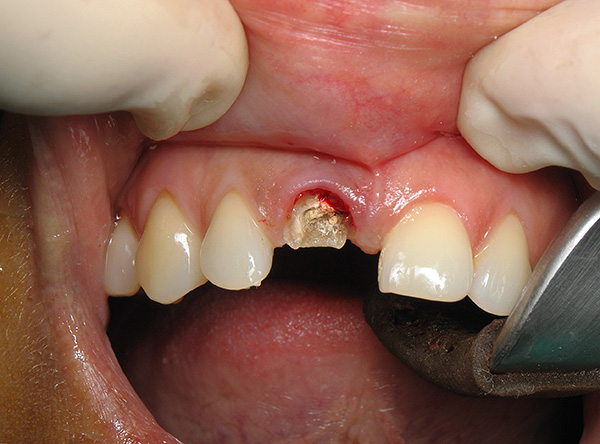
On a note
Situations are different: sometimes you have to remove a tooth urgently, sometimes a plan, but in one case and another, the question immediately arises: which specialist dentist is better to contact? Which doctor can remove a tooth competently and painlessly?
Someone can immediately say without hesitation that you need to contact a dentist surgeon. This, on the one hand, is the correct answer, but in practice, things may not be so simple. The fact is that in polyclinics, hospitals, and even in private dentistry, there is often a situation where one dentist works on a mixed appointment. That is, it carries out treatment (preservation) of teeth that can still be saved, and also removes “bad” teeth, conducts professional brushing, and in addition, the same doctor also deals with prosthetics for missing teeth. Total, we get 2-3 or more specialties “in one bottle”. Should I contact such a specialist?
Of course, it all depends on the professionalism of the doctor and his experience, but in practice, most dentists focus on one area of work, having significantly less experience in other areas. For example, there are mixed-use dentists who devote a lot of time to dental treatment, but they don’t remove it at a very high quality. Here much more depends on the complexity of the work ahead. But after one and a half hours of torment, during which the doctor cuts, drills and even chisels with tools, it is unlikely that any of the patients would like to hear that, they say, the tooth was too complicated and could not be removed (it happens sometimes).
That is why it is best to remove a tooth from a dentist surgeon who specializes only in this manipulation in its various forms.
In addition, there are also maxillofacial surgeons - relatively speaking, they stand at a level even higher than dental surgeons.These specialists are not limited in their work to only “pulling out” teeth (even the most complex), but they can also help with injuries of the maxillofacial region, dangerous complications of periodontitis (periostitis, osteomyelitis, abscess, phlegmon, lymphadenitis), congenital and acquired deformities, diseases TMJ, tumor processes, etc.
For example, with significant problems with opening the mouth, when you need to remove a wisdom tooth with spilled swelling of the face and neck, dislocation of the jaw or fracture, it is worth contacting maxillofacial surgery.
Why teeth sometimes have to be removed
Before tooth extraction, the dentist determines the indications for this in advance, that is, weighs all the pros and cons. There are such clinical situations when a tooth can be considered controversial - this means that the dentist, even taking into account the available evidence, cannot clearly say whether it is worth the risk while maintaining it, or still remove it from sin.
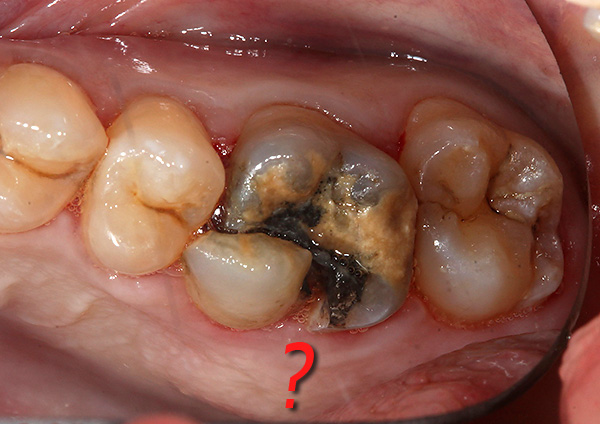
There are also frequent situations when in one clinic they suggest immediately pulling out a bad tooth, and in another they take it to save it.
On a note
Sometimes, in order to recognize a tooth as a subject to be removed, a consultation of dentists of different profiles is convened: general practitioner, surgeon, orthopedist, orthodontist, periodontist.
How to explain such uncertainty in dental practice?
In life, as you know, it is not so simple as it may look in books and textbooks. The indications and contraindications for tooth extraction that exist today were developed back in Soviet times by reputable scientists, and most of them have switched to modern protocols that guide dental surgeons in their practice. However, they may not always be suitable for a specific clinical situation, and there are a number of reasons for this:
- Improving equipment, instruments and methods of dental treatment increases the chances of preserving teeth, sometimes contrary to existing protocols;
- At the same time, thanks to the latest diagnostic methods and modern approaches in dentistry, the dentist alone or collectively can decide to remove the tooth, even if there are indications for its preservation.
The following are examples of key indications for tooth extraction:
- Failure of endodontic treatment in the area of the periapical inflammatory focus (in other words, when a cavity with pus has formed on the root of the tooth, and medical procedures have no effect);

- Emergency cases - diseased teeth, which are the source of an active microbial process, not subject to treatment and provoke diseases such as periostitis, osteomyelitis, abscess, phlegmon, lymphadenitis, sepsis, etc .;
- Technical difficulties associated with curved or difficult to pass canals, leading to the impossibility of conservative treatment, as well as perforation of the tooth cavity or root wall;
- The location of the teeth, leading to permanent trauma to the mucous membrane of the mouth or tongue;
- The mobility of the tooth of the third degree and its extension in connection with bone resorption in periodontitis or periodontitis;
- Location in the fracture line (teeth that interfere with the reposition of fragments and are not subject to conservative treatment);
- Complete destruction of the tooth crown when it is impossible to use the root for orthopedic purposes;

- Ultra-complete teeth that interfere with prosthetics or injure soft tissues, violate aesthetics and chewing;

- Extended teeth with loss of antagonist, as well as those that interfere with the creation of a functional prosthesis;
- In case of malocclusion according to orthodontic indications, even teeth not affected by caries can be removed;
- Some types of root fractures due to mechanical injury.
Wisdom teeth are a separate category, which some dentists recommend removing urgently, while other doctors suggest trying to save them, even at a certain risk of complications.
On a note
There are situations when orthodontic treatment (for example, on braces) cannot be started without removing the wisdom teeth, even if they are completely cut through and do not interfere with the bite.
The same ambiguous situations often arise in relation to the preservation of teeth, for example, when it is impossible to pass the root canals, perforation of the wall or breaking of the instrument in the canal. In one clinic, they can recommend the removal of such a tooth, and formally it falls under the indications, and in another dentistry they can offer tooth salvation using the latest technologies (for example, a microscope plus the removal of fragments of the instrument from the canal using ultrasound).
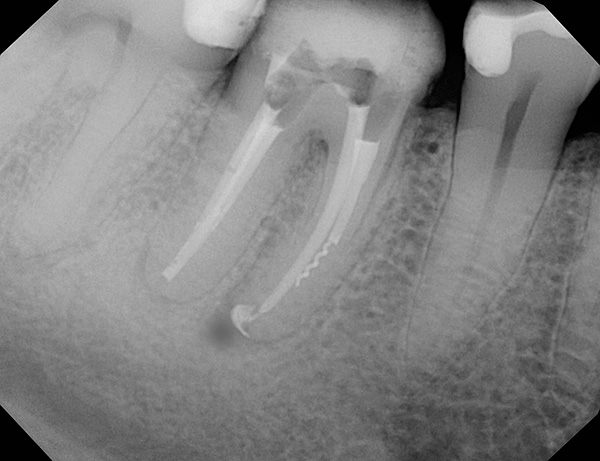
In other words, an individual approach, common sense and medical logic, combined with the experience and professionalism of a doctor, are very important when removing teeth. And it’s not a simple grandfather’s method of cutting from the shoulder, which was not a good life in Soviet times: the tooth is badly damaged - under the forceps, there is no third channel - under the forceps, a small edema appeared in the transitional fold in the projection of the tooth root - also urgent “Tear up” without waiting for periostitis.
Such antediluvian tactics (which, unfortunately, is still sometimes found in some clinics by patients who are tired of the flow of patients and low salaries of doctors) are currently unacceptable and fraught with negative consequences for patients.
Situations when tooth extraction can wait a little or not at all
Despite the variety of options noted above, involving tooth extraction, there are also many situations where it is better not to remove a problem tooth or to postpone it.
The most common situation is related to pediatric dentistry, when parents of children with a carious lesion of a milk (temporary) tooth urgently require a tooth to be pulled out, accompanied by something like this: “Anyway, it will fall out - why treat?”.
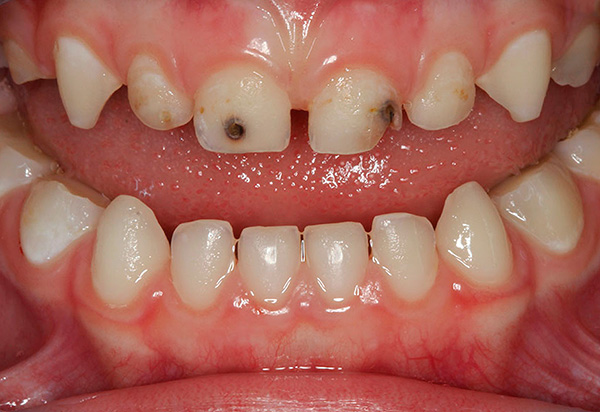
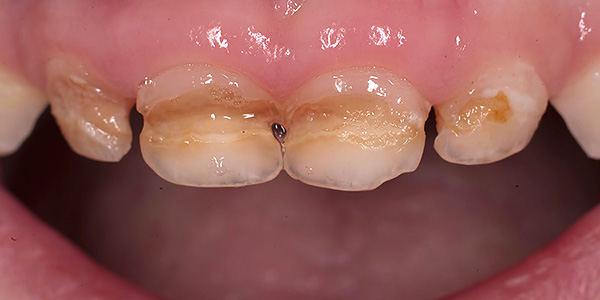
This logic is too straightforward and does not take into account the fact that tooth replacement should normally occur at the appropriate age: symmetrical groups of teeth gradually become mobile and in many cases fall out themselves. If the tooth is removed prematurely (even a year earlier), then there is a high risk of malocclusion and the development of anomalies in the eruption of permanent teeth.
In other words, with early removal of milk teeth (especially multiple), future permanent teeth can literally "split apart" in different directions, or even not erupt in a single or group version. No sane parent needs such a prospect, so it’s better now to save the child from surgical intervention by curing tooth decay or its complications, than to invest energy and money in correcting the occlusion and the child’s psyche.
On a note
Meanwhile, there are clinical situations where acute conditions that threaten the baby’s health and life require immediate removal of a temporary tooth. Or when the tooth can no longer be saved even with modern treatment methods.
As for the impossibility of cooperation between the child and the doctor at the stage of dental procedures: there is not only treatment and extraction of teeth under anesthesia, but also various forms of superficial sedation and sedation, which allow the procedure to be carried out as comfortably as possible and minimize the possibility of the child becoming afraid of a white coat in the future.
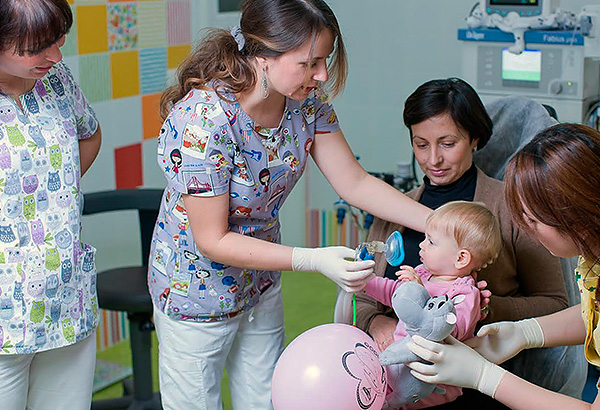
Cases when a person wants to pull out an innocent tooth are quite common in adult dentistry, especially among men and women older than 45-50 years. This is largely due to old memories of remnants of Soviet dentistry, when the tooth at any opportunity (even with caries) was sent under forceps. Until now, such categories of citizens often get an appointment, especially in budget (free) dentistry with requests or even requirements to remove a tooth in case of caries or pulpitis.
For example, a tooth began to ache from a cold, hot, sweet or night pains of a aching nature had just begun, and the patient was already negatively inclined to the treatment of the tooth. Motives can be different: from “love to pull out teeth” (fast, inexpensive and there is no scary drill with its sound) to 100% confidence that after treatment you still have to remove the tooth (negative experience of the past decades, when the teeth were treated for a long time, but in the end I still had to apply for removal).
So, what is important to keep in mind: modern dentistry has long crossed out these prejudices. Now, not only with caries (even deep) and pulpitis, but with most periodontitis, the teeth are treated remarkably, and they do not need to be rushed to remove at all. And even if the tooth, it would seem, has broken down under the root, it is not a fact that the root will need to be removed, since it is quite possible to restore the functionality and aesthetics of the tooth using the root tab and crown.
Stages of tooth extraction: how it all happens in most cases
After, in accordance with the evidence, it was decided to remove the tooth, the preparation stage for the procedure begins.
The photo below shows an example of a broken front tooth to be removed:
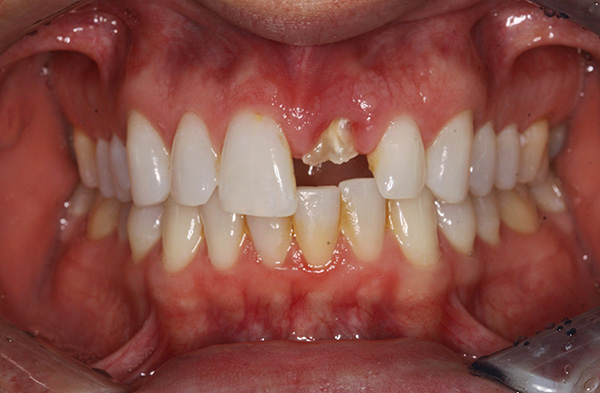
The nature of the preparation depends on the features of future manipulation (with or without anesthesia, with or without sedation), but the most basic steps include:
- History taking (especially allergic status);
- The psychological preparation of the patient (many are afraid, so it is important for the doctor to reassure the patient and set up in a positive way);
- Medical preparation of the surgical field (rinsing the oral cavity with antiseptics, treatment of the injection site).
On a note
It is recommended that you sign up for tooth extraction in the morning when you and the doctor are still full of strength. If anesthesia or sedation is not planned, then it is better to eat well before the procedure - there will be more strength and blood will clot better.
If it is possible to remove the tooth with forceps, then the removal is called simple, and it is carried out in several stages:
- First anesthesia is performed;
- Then gum exfoliation is carried out using a trowel;
- Then the doctor puts forceps on the tooth;
- Nippers advance under the gum;
- After this, the tooth is “loosened" - this is necessary to destroy the ligamentous apparatus that holds the tooth in the socket;

- As a result, a “dislocation” of the tooth occurs;
- Then the tooth is extracted from the hole;
- The final stage is the so-called hemostasis, that is, stopping bleeding with a gauze swab or special hemostatic drugs;
- Without fail, the doctor must give the patient recommendations regarding the correct behavior in the postoperative period (including recommendations for the care of the well after tooth extraction).
In some cases, stitching may be required.
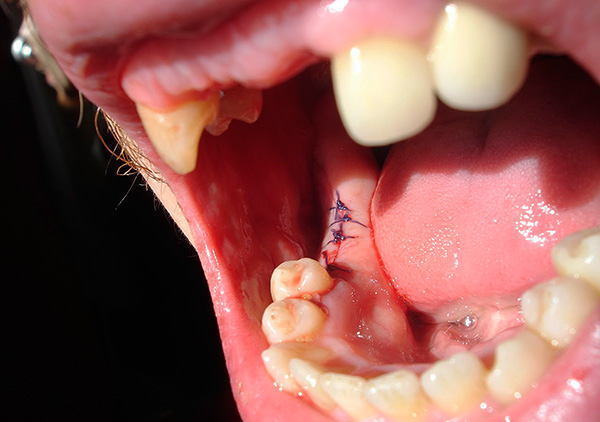
To remove the tooth it was not painful, both domestic anesthetics (for example, Lidocaine) and imported ones (articaine preparations) can be used. It is precisely “articaines” that have been recognized as the most effective today, but the correct technique of anesthesia is also very important - much depends on the level of professionalism and experience of the doctor.
Today in dentistry there are different options for pain relief when removing a diseased tooth. During conduction anesthesia, a group of teeth is “frozen”. A good example can be the torus or mandibular technique: when it is implemented, the patient does not feel the lip, the tip of the tongue and cheek on the corresponding side.
Infiltration anesthesia is done in the projection of the tooth root onto the gum: in this case, freezing occurs only in the extraction zone: almost always this is enough for all the upper teeth, as well as the lower ones, from the first to the fifth. For 6, 7 and 8 of the lower tooth, infiltration anesthesia will not be enough, therefore, a torus is done. If this conductive technique is not done or done poorly, then during the removal of the lower large molars it can be very painful.
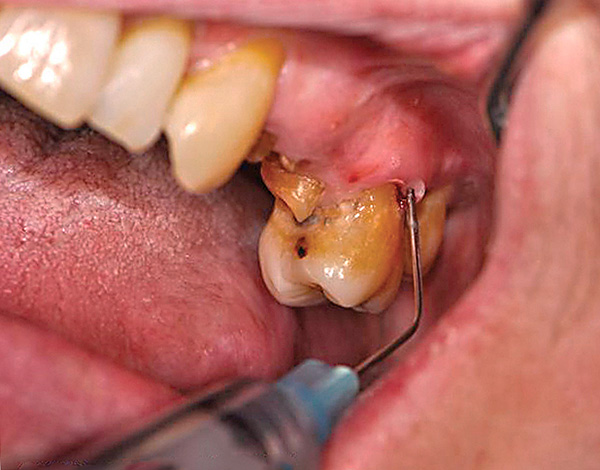
Of the modern methods, intraligamentary anesthesia (intraligamentary) can also be noted. It is done with a special syringe and has a lot of advantages (it does not cause numbness of the face, it comes quickly, lasts for 20 minutes, which is enough for most outpatient removals).
For complex removal, anesthesia is sometimes used. A characteristic difference between a complex tooth extraction and a simple one, in addition to the time taken, is the use of a drill (for sawing a tooth into pieces, cutting a bone), screws, ligatures and some other specific tools (sometimes a tooth is literally split into pieces with a chisel and hammer).
The photograph below shows an example of a tooth sawn before removal into three parts using a drill:
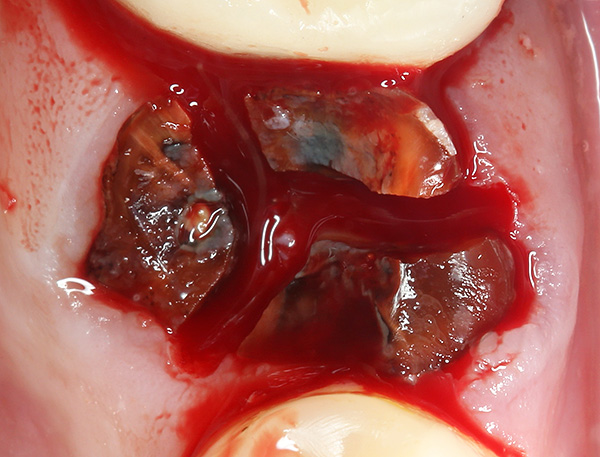
On a note
A dentist-surgeon cannot always determine in advance whether tooth extraction will be difficult or simple. In many cases, the doctor can only approximately guess which tooth should expect difficulties, and which one will almost “jump out” of the hole during removal.
Sometimes a specialist immediately sees a potentially complex tooth (resorcinol-formalin, semi-refined, refined, with specific roots) and warns the patient in advance that the procedure will be difficult and uneasy.
Feedback:
“The day before yesterday I removed the lower tooth of wisdom. It was a real nightmare ... For more than an hour they sawed a tooth, hammered it, broke out the roots, almost broke their jaw. They cut the bone and turned everything there completely. The most terrible sensation is when the doctor tried to break out the tooth several times, I thought that he would dislocate my jaw or break it. All four roots of the tooth stuck in different directions, so it was removed badly. Now my face is swollen, the pain is terrible, I can’t swallow normally and open my mouth. The doctor said that he had not seen this for a long time ... "
Natalya, Moscow
The option of tooth extraction without scary forceps: ultrasound technique
In order to minimize trauma to tissues during tooth extraction, which means to accelerate and make more favorable the process of subsequent healing, there is a so-called atraumatic method of tooth extraction. Such removal could be classified as complex, but the use of additional tools (drills, periotomes, etc.) in this context, on the contrary, simplifies the procedure, reduces it in time and makes it minimally traumatic.
Suppose a patient has a severely damaged upper sixth tooth (at the level of the gum or even under the gum), however, the roots do not exist independently, but are combined into one. With the help of a drill, the crown part of the tooth in the middle is gently cut out: each root becomes independent. The periodiotome allows you to quickly and accurately remove them without damaging the partitions, walls of the alveoli, as well as the gingival margin.
The photos below demonstrate the individual stages of the atraumatic method of removing three teeth at once with a preliminary cut:
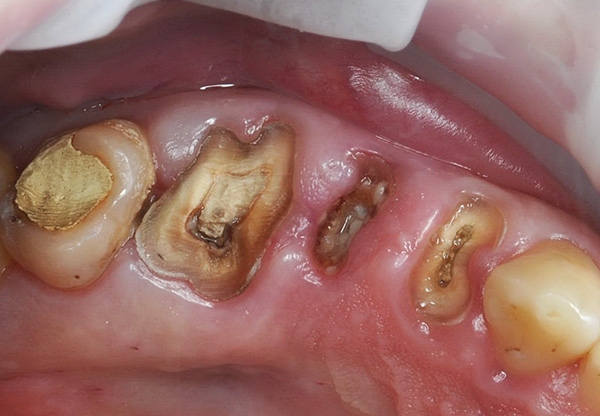
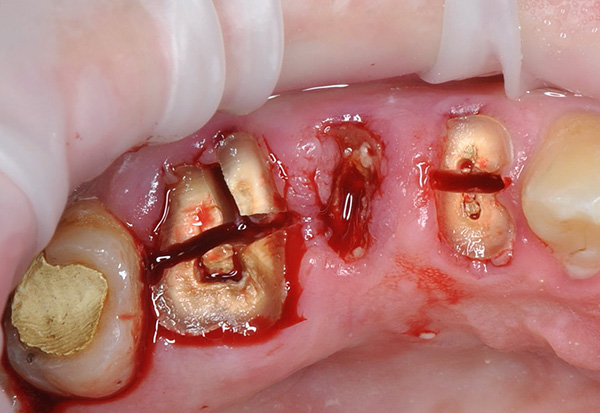
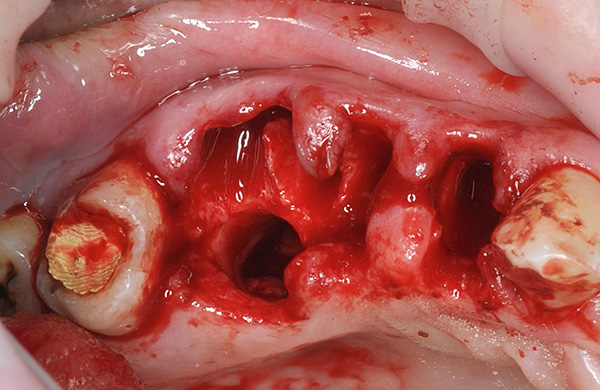
On a note
If in this case only forceps were used, then the forceps cheeks would have to be advanced deep under the gum in order to “loosen” and “dislocate” the soldered roots. In 50% of cases, this will turn out, but with a different degree of breaking of the outer and inner root-retaining walls. After such removal of the root, uneven or sharp bone tissue remains, new problems are created for both the doctor and the patient.
Often, with the help of forceps, the extraction of complex teeth cannot be carried out at all, and the result is only a waste of time and useless “biting” with forceps of both the alveoli and the roots.
Atraumatic tooth extraction can also be accompanied by the use of ultrasound. It is precisely this technique that modern clinics are currently actively using as know-how.The piezosurgical apparatus allows using an ultrasonic scalpel to bloodlessly separate the periodontal ligaments that hold the tooth and remove it from the hole.
The main advantages achieved by tooth extraction using ultrasound:
- Bloodlessness;
- Acceleration of work;
- Antiseptic effect;
- Lack of overheating;
- Help with the removal of complex teeth (retinirovanie, semi-retinirovaniya, distopirovaniya, resorcinol-formalin).
This type of atraumatic tooth extraction is ideal for subsequent immediate implantation when the implant is inserted immediately into a fresh hole.
Features of the removal of potentially problematic teeth (refined, semi-refined and resorcinol-formalin) - is it worth it to be afraid?
For the removal of retined and semi-reinforced teeth (that is, non-cut or erupted only partially and largely hidden in the jaw bone), as well as resorcinol-formalin teeth (that is, previously treated with resorcinol-formalin paste and which have become brittle), the doctor can apply as anesthesia, if there are indications for it, and local anesthesia.
Most often, these teeth are removed under local anesthesia.
The image below shows a retarded wisdom tooth:
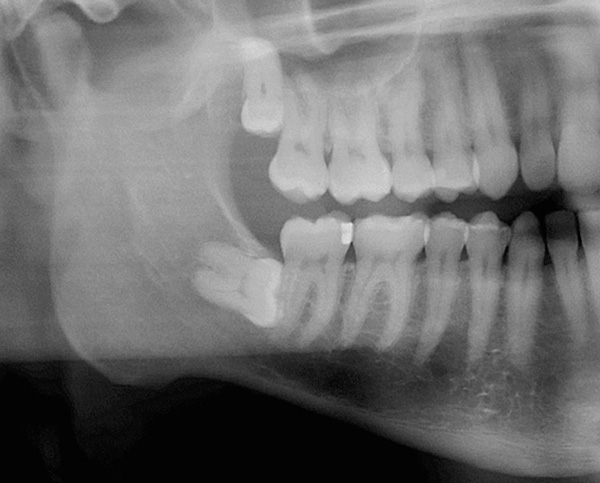
From the practice of the dentist
Some budget dentists (especially in small towns and villages) who work on mixed visits (therapy plus surgery) are afraid to remove teeth from this category. Seeing a semi-refined or, especially, a refined tooth (from the picture), they can immediately refuse to be removed and send the patient to the maxillofacial surgery to the nearest regional clinic or dental center. The motivation for this can be both reluctance to bother with these teeth (it may take 1-2 hours of painstaking work for the procedure), and fear that the lack of experience and tools will not allow you to remove all the roots - which means that you will still have to send the tormented patient to another more qualified dentist in this matter.
Stages of complex tooth extraction:
- Preliminary preparation (premedication, processing of the surgical field, etc.)
- Anesthesia (general or local);
- Creating access to the extracted tooth;
- Instrumental technique for improving conditions for “dislocation” of tooth roots;
- Root extraction;
- Hemostasis;
- Preservation of the hole to prepare for implantation (as indicated);
- Suturing (according to the situation);
- Appointment of recommendations.
Creating or improving access to a tooth involves the use of elevators, a periotome, a trowel, a drill with a set of burs and cutters, and (rarely) a chisel and a hammer. After the access to the extracted tooth is partially created (gum retraction, flap detachment), the tooth is removed by the elevator, and if this is not possible (as with retinated ones, for example), then the alveoli bone is cut out by milling in the projection of the tooth location. At the same time, cooling is applied to the preparation area, since the bone tissue should not overheat, otherwise necrosis will develop.
When the tooth being removed becomes visible, the surgeon can immediately begin to use elevators to “pick up” it. Often, to facilitate the operation of the tooth can be sawn (or split) into parts.
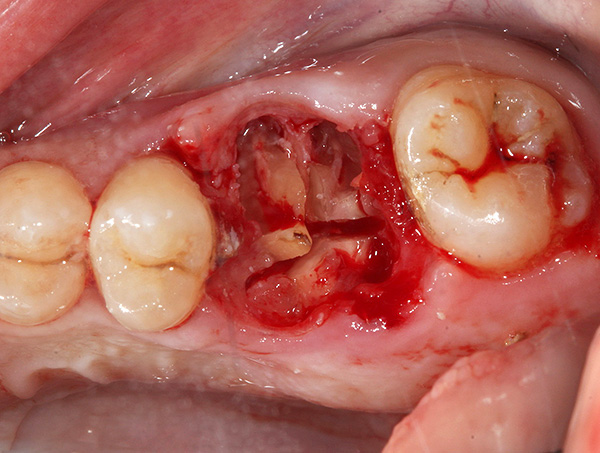
On a note
How long can such a complex removal take? Depending on the complexity of the procedure, the availability of necessary tools and the experience of the doctor, the procedure can take from 10 minutes to 2 hours.
After extraction of a diseased tooth and removal of a granuloma or cyst from the socket (if any), suturing is performed and recommendations are appointed. In some situations, canning is performed before subsequent implantation, so that there is no atrophy of the bone walls. For this, natural bone substitutes are used, or synthetic (inorganic bone matrix).
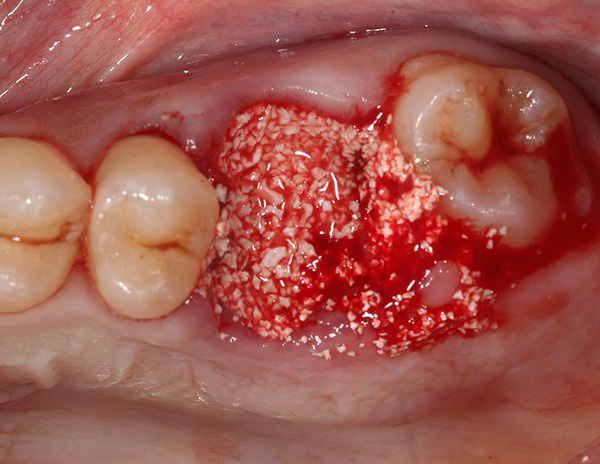
After a complex tooth extraction, the doctor must prescribe home treatment to ensure the maximum comfortable postoperative period and prevention of alveolitis, which may include drugs of various directions:
- Painkillers (Ketorol, Ketanov, Nise, etc.) for pain relief in the first days after surgery;
- Antibiotics and sulfa drugs (to eliminate a bacterial infection in the maxillofacial region);
- Antihistamines (to reduce edema and other manifestations of the inflammatory reaction);
- Preparations for rinsing and treating the area of removal (gels, ointments) of anti-inflammatory, wound healing, analgesic, antiseptic and antibacterial effects.
On a note
Generally speaking, the list of recommendations that exists in the arsenal of dentists in Russia is huge, and each dentist adheres to his list of necessary postoperative treatment. Someone prescribes the same thing to each patient, but someone has an individual approach (which is the most correct).
But it should be borne in mind that some dentists may not say anything to the patient at all, even as parting words or advice. If you have a tooth removed and no recommendations have been made, be sure to ask them, or ask another doctor, as this helps to avoid unnecessary anxiety and very unpleasant complications.
How to help your doctor so that tooth extraction can be completed without problems
Despite the fact that in dentistry anesthesia is used before tooth extraction, there is always a risk that the procedure may not go as smoothly and painlessly as we would like. This is often due to the fact that the patient is not ready for the procedure and does not behave quite correctly.
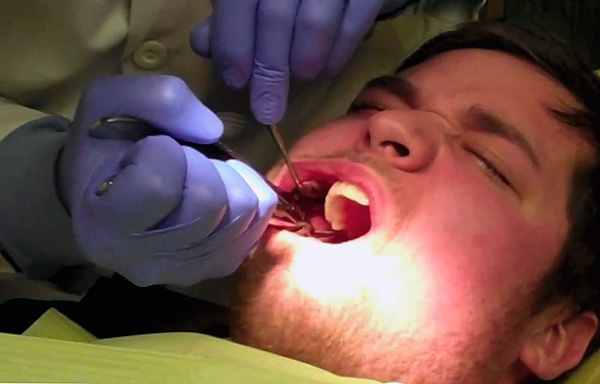
Let's see how to prepare for tooth extraction in order to at least help a good doctor to perform manipulation without any problems.
Firstly, surgical intervention on a “neglected” tooth, when the stage of the acute process has reached its climax (one cannot even touch the root due to pain, a “flux” has arisen) is tolerated in many cases much worse than the planned removal of a “calm” tooth. Moreover, in this context, it does not matter which tooth will have to be removed: the molar (six, seven, eight) or some front tooth will be removed.
It is not difficult to imagine what unforgettable emotions a patient (as well as a doctor) can experience when he has to remove a diseased tooth or its remnants against a background of periostitis and other purulent complications, when anesthesia is almost not working, and any touch to the tooth causes hellish pain. But the tooth needs to be loosened! At the same time, there is still a risk that the rotted crown part may break off and you will have to separately “pick out” the roots ...
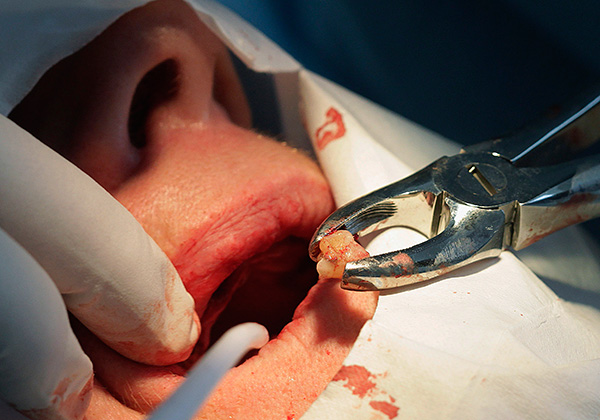
It is interesting
Often anesthesia is done in the projection of the root of the tooth, when pus is everywhere under the gum in this area. At the same time, the “sufferer” demands from the dentist-surgeon that everything be absolutely painless: “Take a strong injection, doctor, if only it would not hurt!” However, it is immediately clear that where the pus is located, they are a priori “not happy” with the new solution: there is nowhere to put the exudate already.
A bad doctor, as a punishment for such a patient who went to the doctor’s office for too long, will simply inject the entire portion of the anesthetic at a time, and the sensation of the procedure will be similar to removing the tooth without anesthesia, when there is already a “spark from the eyes” from the pain. A normal surgeon will, in stages 2-4, gradually gouge the gum with an anesthetic, release milliliters of purulent fluid in order to exclude pain during drug administration and try to achieve stable anesthesia for painless tooth extraction.
So excessive patient patience before going to the doctor can cause a lot of problems.Therefore, if it is known for sure that a badly damaged tooth must be removed, then it is better to get rid of it planned: make an appointment and, in the absence of contraindications, end the problem once and for all, until the tooth becomes ill.
For tooth extraction, an ideal option would be to book in the morning:
- In the morning, the body has a lot of strength and energy, it tolerates stress and emotions easier;
- After removal, after a while, pain and discomfort appear, but towards the evening most often their intensity decreases, and you can sleep peacefully;
- In the morning, the dentist-surgeon can devote more time, fatigue has not yet accumulated, and the surgical room (especially in clinics and hospitals) is as clean as possible;

- After morning removal, in the event of a problem (prolonged bleeding, severe pain, swelling, etc.), it is much easier to consult your doctor again than to run around at night and look for a dental institution working around the clock.
There are a few more practical tips that help the patient safely transfer the tooth extraction procedure:
- Before tooth extraction, eat well (unless anesthesia or sedation is planned). A well-fed person copes with stress better, faints much less, and blood clots better, which is important after the procedure;
- Do not take alcohol for courage. The risk of edema and prolonged bleeding in drunk people is increased, not to mention inappropriate behavior;
- In case of great fear of the procedure or fear, you can resort to sedatives (Tenoten, tincture of valerian, motherwort, Corvalol, etc.) 20-60 minutes before surgery, depending on the activity of the drug. In this case, the choice of the drug must be coordinated with the attending physician or local therapist and have an idea of the measure (especially regarding alcohol tinctures, since their intake can smoothly turn into intoxication);
- It is good to have a positive attitude. If you are initially set up for a successful outcome of the procedure, then almost always the removal is wonderful, and the healing time is as short as possible. The more a person tells himself that nothing will turn out and the more he winds himself up, the more he and the doctor are disturbed, sometimes simply because of anxiety, commit the wrong actions (using unnecessary ointments, rinses, dangerous folk remedies, etc.) ;
- When planning complex operations (removal of a difficult retined tooth, all wisdom teeth at once, etc.), it is recommended to consult with your doctor about taking anti-inflammatory, analgesic drugs and even antibiotics before the intervention.
If a tooth is declared unusable, then in emergency cases it is removed urgently. But there are situations when the patient is going to turn to remove the tooth as planned - in these cases sometimes it makes sense to postpone the procedure.

So, it is not recommended to carry out tooth extraction with:
- ARVI and ARI in the active period;
- Painful and heavy periods;
- Cardiovascular diseases, when their treatment is accompanied by the use of certain drugs (for example, anticoagulants - Warfarin, Xarelto, etc.);
- Pregnancy (for some periods - an exclusively individual approach);
- Acute diseases (acute appendicitis, acute pancreatitis, etc.).
It is not difficult to guess that after the disappearance of many of these conditions, you can safely consult a doctor about a planned tooth extraction.
What to do if you need to urgently remove a tooth at night, on weekends or holidays?
Often you can observe a panic among residents of large cities and megacities, when a badly damaged tooth suddenly starts to hurt on weekends or holidays. That is, emergency surgical care is required, and the person is clamped in four walls and does not know where to go for tooth extraction and what to do in general.
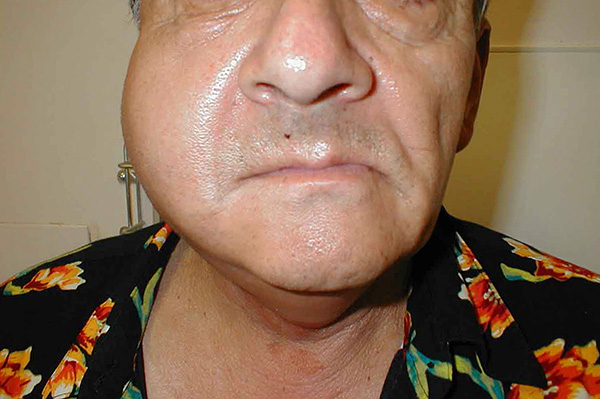
Meanwhile, it doesn’t matter what day it is (Sunday, March 8, New Year or another holiday), because in the cities there is a round-the-clock emergency dental care with a schedule of dental surgeons on duty. It is enough to contact the regional dental clinic or regional hospital with a department of maxillofacial surgery.
But not only in large cities there is an "ambulance" in dentistry. Even in the district center at night, on weekends and holidays, as patients say, you can “tear” your teeth after a preliminary call to the post. Usually it looks like this: you call an ambulance or a paramedic post, you learn the possibility of urgent tooth extraction. The specialist contacts the dentist on duty, and he arrives in the office for an hour in order to help you (if the dentist conducts his appointment on schedule on holidays, then most often he has to be called).
As for the private sector, everything is much simpler here. There are dentistry that lead reception around the clock. Doctors in such clinics work in 3-4 shifts, and are ready to remove a tooth at any time when necessary.
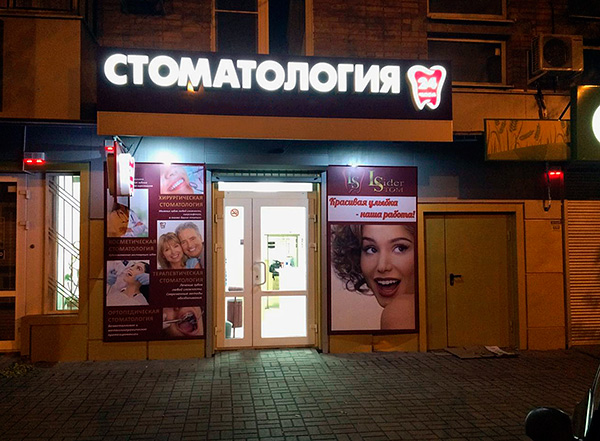
On a note
The night shift is popular not only among people whose pain was taken by surprise, but also among those working late at work for parents of babies whose teeth are ill. In addition, many people engaged in business have free time only after 22:00, and some even after 00:00.
Is it possible to remove teeth for free in hospitals today?
But what about those people who do not have money to remove their teeth in a frequent clinic? Moreover, the price for such services today varies, depending on the region and the complexity of the procedure, from 500 rubles. up to 20 000 rub.
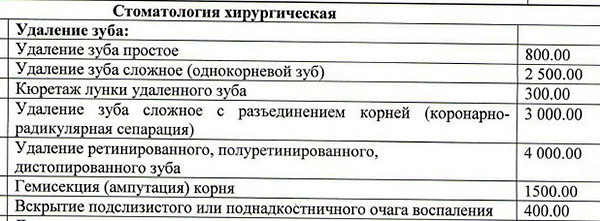
Someone might even be surprised at such a high price - to pull teeth for 20 thousand rubles for one tooth pulled out? Is it too expensive ?!
On a note
The fact is that 20 thousand rubles is also not a maximum for tooth extraction, since there are complex clinical cases that require increased time and materials.
Usually an additional mark-up is made on the following varieties of removal (below are the wording from the price lists of clinics):
- “Atypical tooth extraction” (that is, complex);
- "Laser" (using a laser scalpel);
- "Using ultrasound";
- “Without tongs”;
- "In a dream" (anesthesia or superficial sedation).
The list goes on and on. Moreover, for example, atypical removal in clinics often means not only complex tooth extractions, but also the removal of any wisdom tooth, even if the removal is simple. This is most often done for commercial purposes, since a kind of escalation of fear in patients with wisdom teeth allows you to set a higher price in the price list for getting rid of them.
So is it still possible to remove a tooth cheaply?
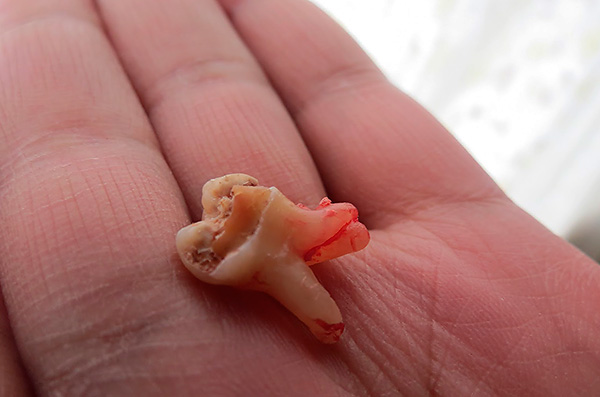
Firstly, given the great competition, private dentists charge different prices for the same service, and the price can be very affordable, regardless of what kind of tooth it is: a canine (or, as patients often call it, an “eye tooth”) , a wisdom tooth or any other chewing. It happens that in one clinic you can remove a wisdom tooth for 1000 rubles, and in another - they will offer a price of 5000 rubles.
Both there and there, the removal is paid, and the main question that confronts the patient is whether it is possible to trust a more budgetary option?
According to the recommendations and reviews of relatives, friends and colleagues, you can almost always find a professional doctor who removes teeth well. At which the cabinet wall is not even hung with dozens of certificates and certificates, but who knows his job well and is attentive to the patient. There are small private offices where they can remove a tooth for 500 rubles painlessly and efficiently without cheating for coffee, magazines, leather chairs and other surroundings.
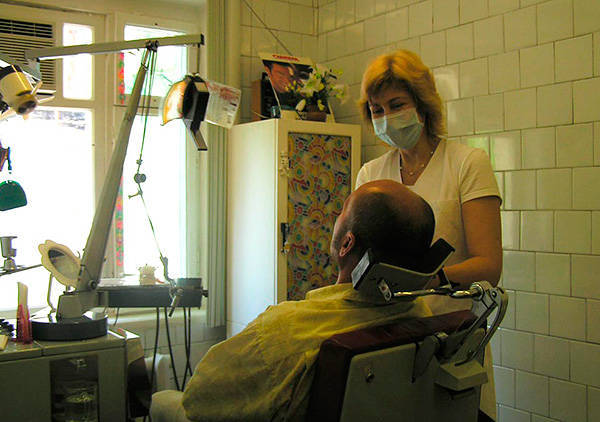
Another thing is that you need to go to such a specialist on the recommendation of trusted people, and not just go to remove a tooth in the first clinic you come across, where they will offer the lowest cost of service.
Is it possible to remove a tooth qualitatively, but for free?
Free cheese (especially in dentistry) can only be in a mousetrap - perhaps this is the first thing that can come to mind in such a case. However, annually hundreds of thousands of citizens receive free surgical care according to the usual MHI policy.
The principle is as follows: a person who is attached to this institution applies to a hospital or polyclinic at the place of residence for the purpose of removing a tooth. A dentist’s coupon is punched for him, and on this coupon he removes one or more damaged teeth for free. If there is no attachment, and the coupon does not pass through the computer, then you can also remove the tooth, of course, but it’s already paid.
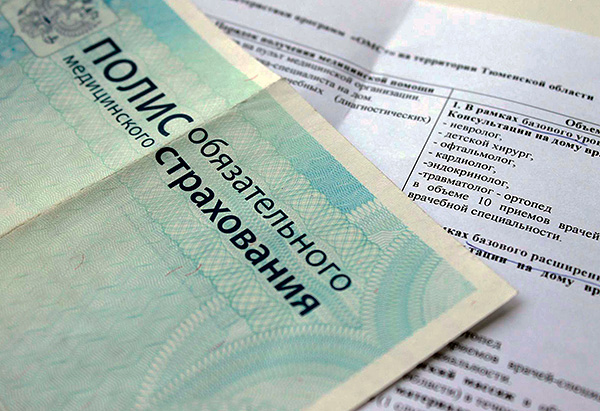
If the dentist cannot perform the removal (for example, it is a retarded or resorcinol-formalin tooth, or there is diffuse swelling, life-threatening, specialization is required for children, etc.), then the patient has the right to receive a referral for free help, where the medical institution, the direct diagnosis according to ICD-10 and the need for this or that manipulation will be indicated.
On a note
There is also a list of free drugs that a dentist in the compulsory medical insurance policy can provide to the patient at the stage of care. This is especially true for anesthesia.
Not all hospitals (especially in villages, settlements, small towns) regularly and in full receive the necessary materials. Most often they are supplied with domestic preparations for anesthesia (Lidocaine, for example), although today, according to the compulsory medical insurance, there are even anesthetics of the articaine series on the list, which, however, practically do not reach the addressee. In order to work as comfortably as possible and to be able to provide high-quality anesthesia to the patient without risking his health, dentists are forced to remove the tooth for a fee, where a person pays money for a “good injection”. Of course, this is cheap compared to a private clinic, and costs about 100-400 rubles, depending on the region.
But this does not mean at all that free tooth extraction “under lidocaine” will certainly be painful. Free removal in many budgetary institutions can mean increased risks, ranging from the fact that an anesthetic injection will be whipped up and will not work as expected, and ending with a long hours-long queue of the same sufferers in the corridor with the probability of receiving from a tired surgeon for any sloppy spoken word with a three-story mat on the ears.

So here everyone chooses where to apply for tooth extraction and how much he is willing to pay for this service. In conclusion, we can only note that having decided on the budget, one should not look for a clinic, but first of all a good doctor - this will be the key to the fact that tooth extraction with a high probability will be almost painless and without any extra problems.
Be healthy!
An interesting video with an example of atraumatic tooth extraction with ultrasound
What to do after tooth extraction to avoid complications

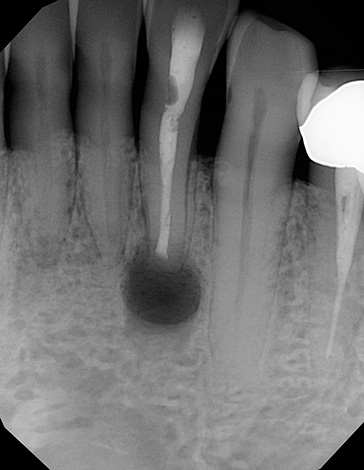
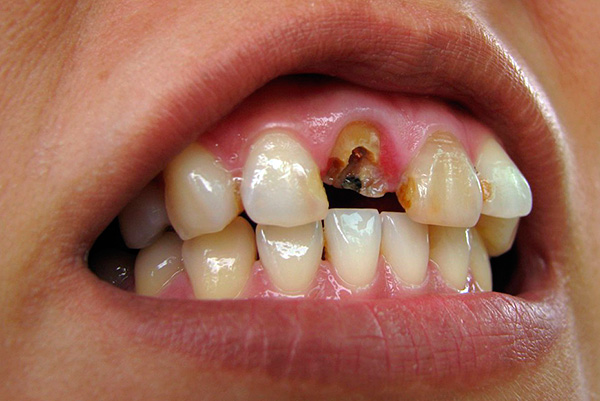
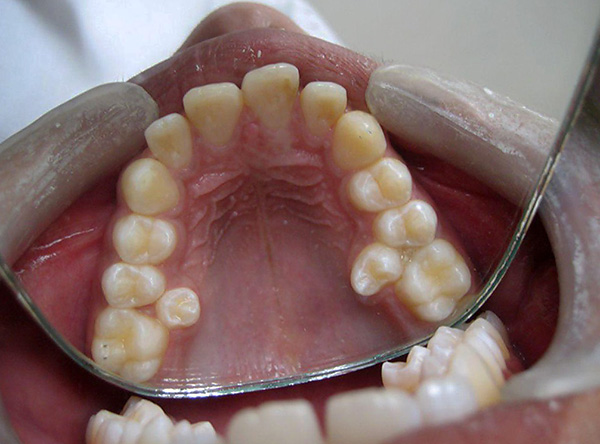
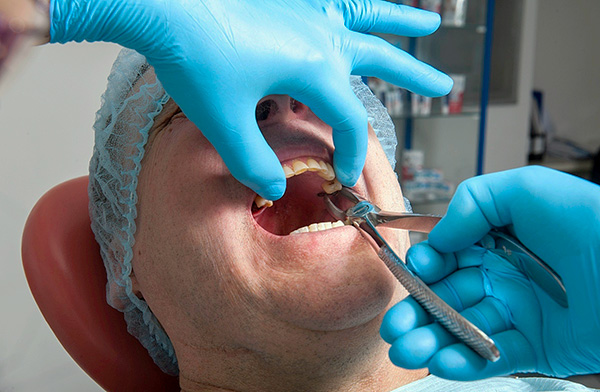
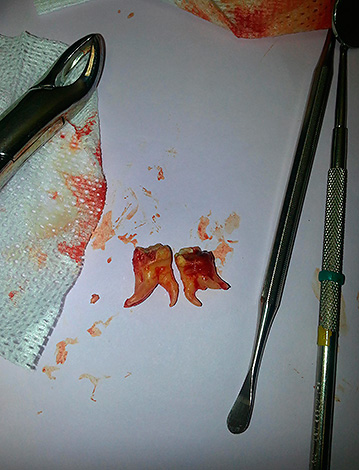
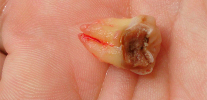
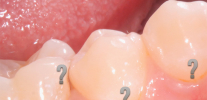
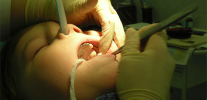
In Soviet times, they treated and removed for free, and no one was afraid for their health. The state and people became insolent ... And there is no money, where to go? Drink water and fold your hands ...
Good afternoon. They removed my lower wisdom tooth. It was deleted very hard, about an hour. Since the tooth itself crumbled, I had to cut it and remove it with a machine. Sewn up the gum. The cheek and chin were swollen. 2 days have passed, the edema does not go away, and there is also a bruise on the chin. Tell me, how much time must pass for the tumor to pass and bruises?
Hello, Larisa. After the tooth extraction described by you, such complications are quite normal. The growth of edema can occur even 3-4 days after the manipulation. Then everything goes into decline. The bruise will come down too. As a rule, within 2 weeks everything goes away.